The electrical properties of conductive polymers can be significantly altered through doping, which allows for the control of their resistivity. Accurate measurement of the electrical resistivity of these materials is essential for understanding their performance and application potential. In the semiconductor industry, the four-probe method is widely used to measure the resistivity of inorganic semiconductors. However, conductive polymers, being organic semiconductors, have different conduction mechanisms and a much wider resistivity range—spanning from 10-3 to 1010 Ω·cm. As a result, the traditional four-probe method often fails to meet the specific requirements of measuring such materials.
Currently, when measuring higher resistivity values, the national standard GB3048.3-83 provides a reference for constructing the measurement circuit. However, this approach has several limitations. It demands precise sample geometry, requires extensive time and effort to set up the circuit, and presents challenges in controlling the excitation voltage. If the voltage is too low, it may lead to poor measurement accuracy, while if it's too high, it could generate excessive current, potentially damaging the sample or even posing safety risks. To overcome these issues, avoid complex pre-treatment processes like tableting or molding, and ensure accurate and safe measurements across a wide range of resistivities, improvements have been made to the measurement system.
1 Measurement Principle 1.1 Four-Probe Resistance Measurement MethodThe four-probe method is designed to minimize the impact of contact resistance and wire resistance. Instead of using a constant current source between probes 1 and 4, a constant voltage signal (Vs) is applied. This setup is illustrated in Figure 1.
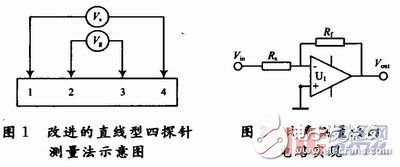
Current through the sample:
Where: Rw represents the wire resistance; Rct is the contact resistance at probes 1 and 4; R14 is the resistance of the sample itself.
To determine the sample current I, the total resistance Rx must be calculated through other means. A ratio measurement technique is introduced here, as shown in Figure 2.
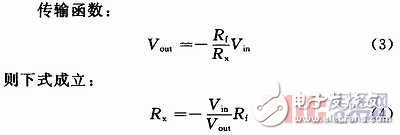
In this setup, Vin is the input reference voltage (corresponding to Vs in Figure 2), Vout is the output voltage from the amplifier circuit, and Rf is the feedback resistor. By adjusting these parameters, the measurement system can achieve greater accuracy and stability.
1.2 Measurement Resolution The theoretical resolution of the resistance measurement depends on the input voltage and the feedback resistor. As the resistivity of the sample increases, the resolution tends to decrease sharply. To maintain high resolution across the full measurement range, two strategies are employed:
(1) Increasing the value of Rf when measuring larger resistances;
(2) Adjusting the excitation signal voltage based on the expected resistance range.
Using program-controlled amplification technology, the system is designed with multiple gear positions corresponding to different resistance ranges. Each gear position uses an appropriate excitation voltage, as detailed in Table 1.
When measuring the resistivity of semiconductor materials, the current passing through the sample must be carefully controlled:
(1) The current should not be too small, as this may make the voltage between inner probes unmeasurable;
(2) The current should not be too large to prevent thermal effects from influencing the resistivity;
(3) For high-resistivity samples, the injection current should be reduced to minimize the effect of minority carrier injection.
While the current affects the measured resistivity value, it typically does not alter the overall resistivity range. The safe operating current can be determined based on this range. The current flowing through the test sample in this method is given by the following equation:

The system is built around the LPC2148 ARM7 microcontroller, serving as the core unit for mathematical computation and control. The overall system architecture is illustrated in Figure 3.
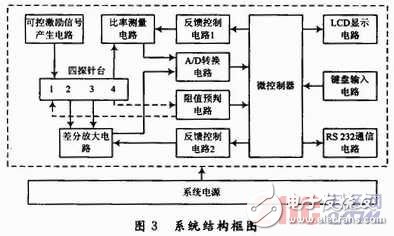
The control processing unit includes an LCD display, a keyboard input interface, serial communication circuits, and two feedback control circuits. A preset current-limiting resistor Rc is used to define the current for low-resistivity materials, and the current can be calculated using Equation (9). Throughout the entire measurement range, the current is kept below 2 mA. The parameter settings and gear positions are listed in Table 1.

This unit consists of a controllable constant voltage source, a differential amplifier, a ratio measurement circuit, and an analog-to-digital (A/D) converter. The constant voltage source uses the ADR01 chip to generate a 10 V reference voltage, which is further divided into 0.1 V and 0.01 V signals. The voltage between the inner two probes in Figure 2 is measured using the AD620 differential amplifier and a high-precision op-amp, AD546. Feedback control circuit 2 adjusts the gain resistor RG to fine-tune the output signal amplitude. The A/D conversion is performed using a 16-bit ∑-Δ type ADC, AD7705, which achieves a resolution of 52 μV per LSB when using a 3.401 V reference voltage. The configuration is shown in Figures 4, 5, and 6.
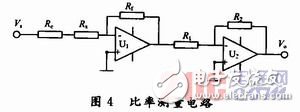
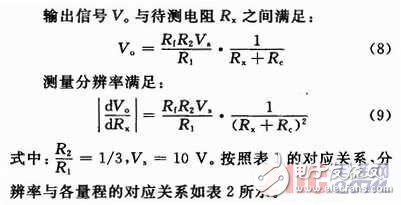

ZGAR Disposable Vape
ZGAR electronic cigarette uses high-tech R&D, food grade disposable pod device and high-quality raw material. All package designs are Original IP. Our designer team is from Hong Kong. We have very high requirements for product quality, flavors taste and packaging design. The E-liquid is imported, materials are food grade, and assembly plant is medical-grade dust-free workshops.
Our products include disposable e-cigarettes, rechargeable e-cigarettes, rechargreable disposable vape pen, and various of flavors of cigarette cartridges. From 600puffs to 5000puffs, ZGAR bar Disposable offer high-tech R&D, E-cigarette improves battery capacity, We offer various of flavors and support customization. And printing designs can be customized. We have our own professional team and competitive quotations for any OEM or ODM works.
We supply OEM rechargeable disposable vape pen,OEM disposable electronic cigarette,ODM disposable vape pen,ODM disposable electronic cigarette,OEM/ODM vape pen e-cigarette,OEM/ODM atomizer device.

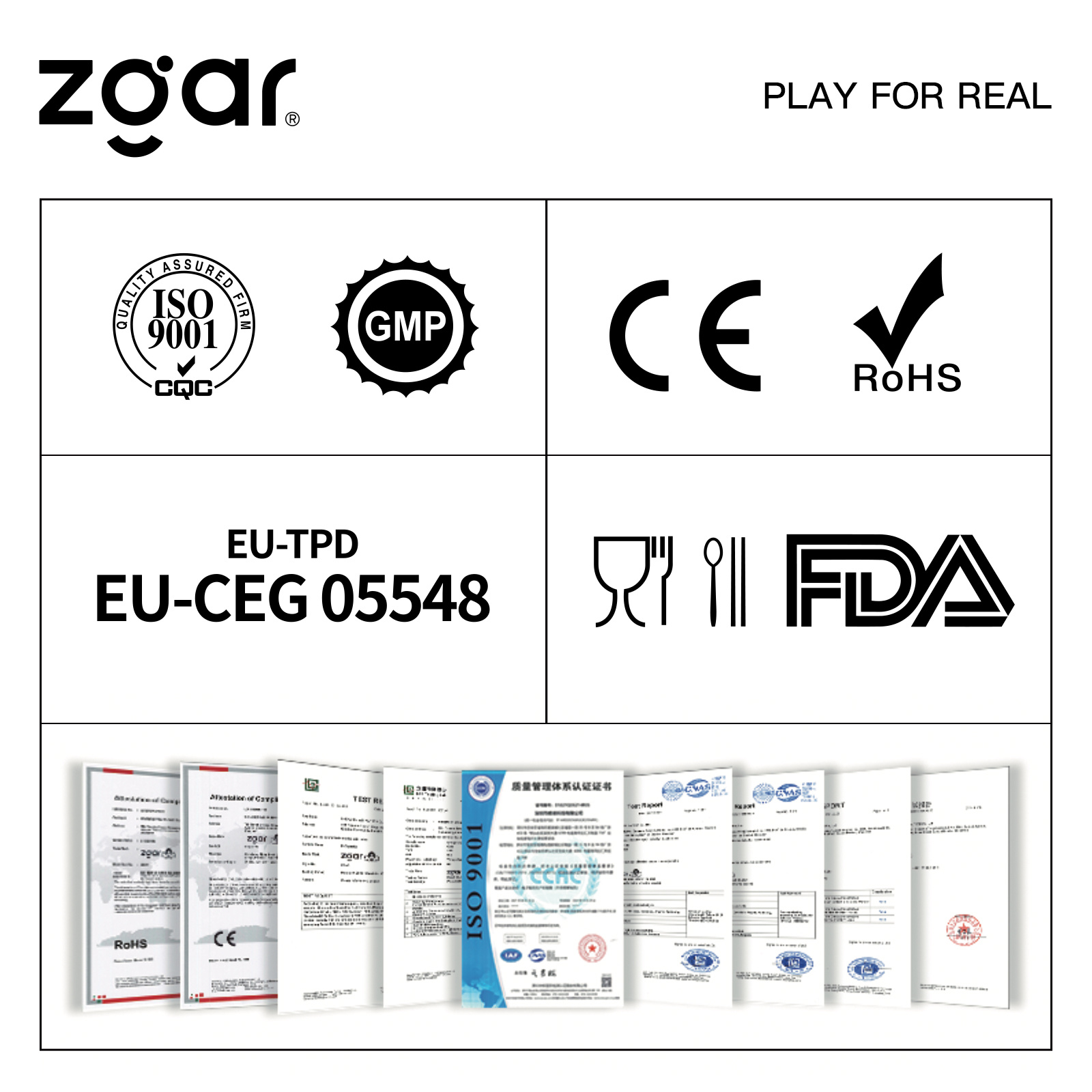
ZGAR Disposable Vape,ZGAR Disposable Vape disposable electronic cigarette,ZGAR Disposable Vape pen atomizer ,ZGAR Disposable Vape E-cig,disposable electronic cigarette
Zgar International (M) SDN BHD , https://www.zgarvape.com